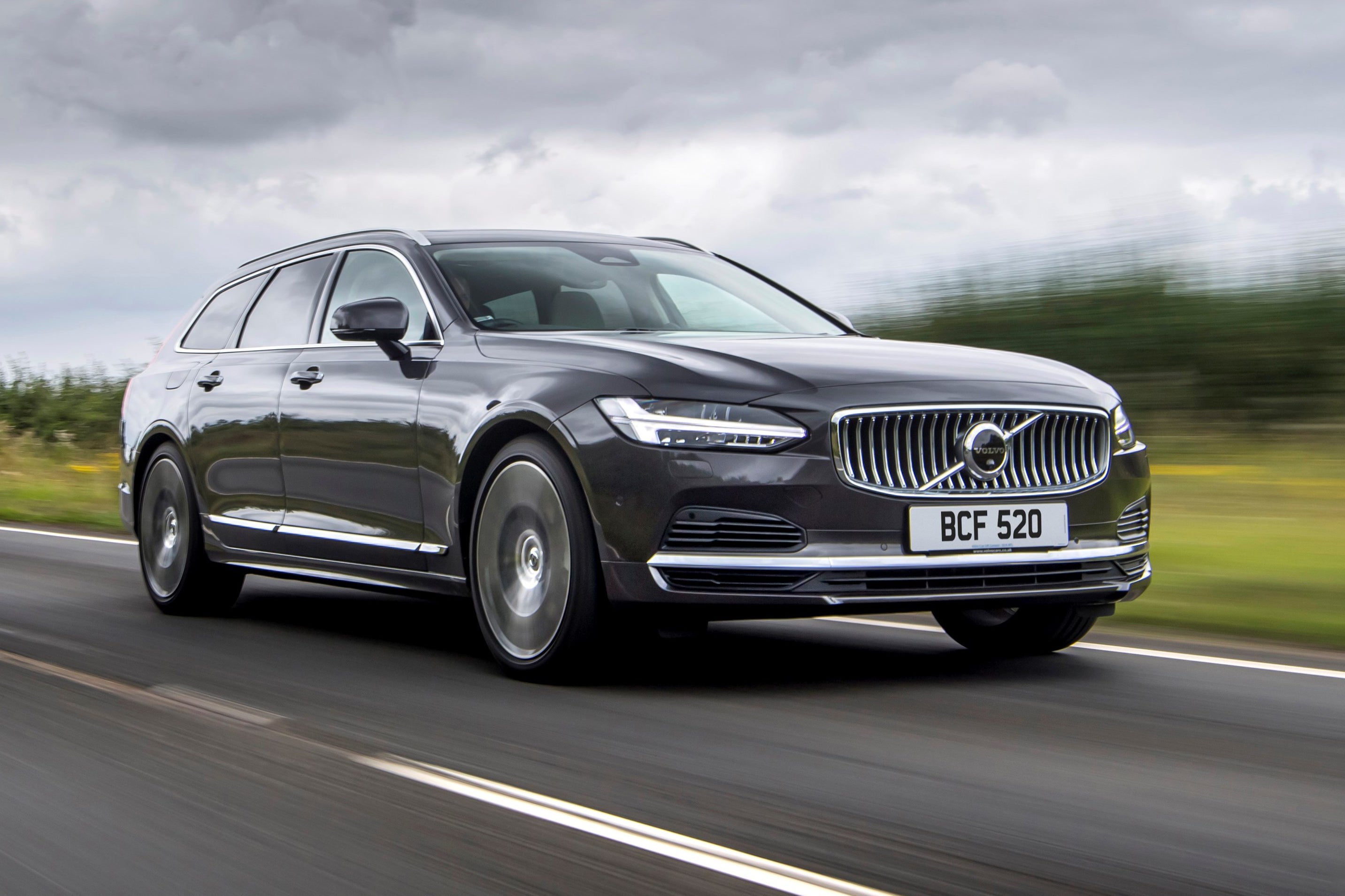Volvo V90 Review 2024
Written by Phil Hall
Quick overview
Pros
- Clean, modern design
- Attractive, spacious cabin
- Clever hybrid tech
Cons
- Not exciting to drive
- Expensive top models
- Bigger wheels hurt ride quality
Overall verdict on the Volvo V90
"The Volvo V90 offers something a little different from German rivals, with tasteful design inside and out, plus a focus on comfort and effortless pace from the PHEV powertrains. It all makes for a very satisfying ownership experience."
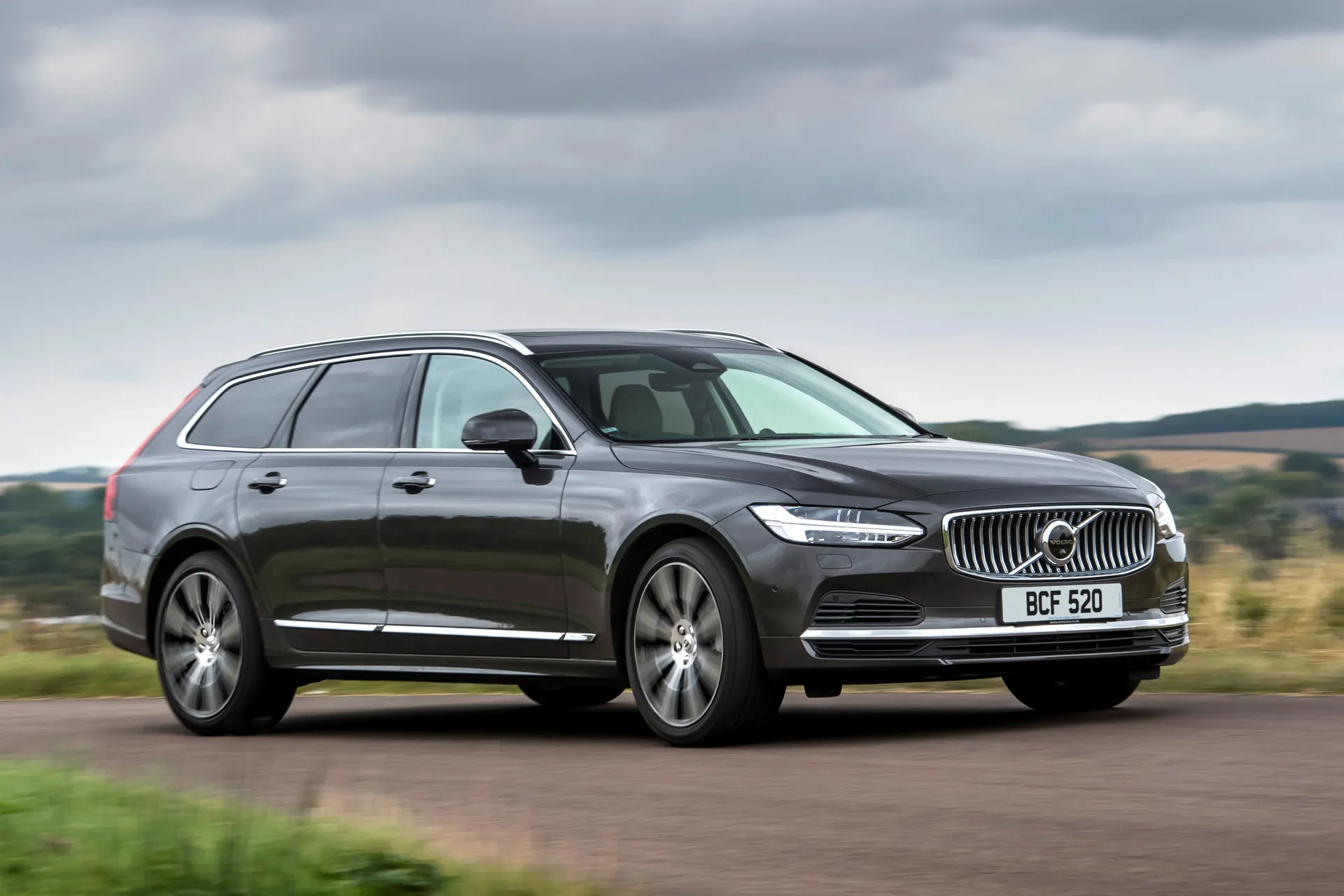
The Volvo V90 is a very significant car, because it marks the end of an era. You see, Volvo is a company that's traditionally been famed for its long history of building excellent large estate cars. The V90 is just such a car, but it also happens to be Volvo's last. That's because the Swedish firm has discontinued all its saloon and estate cars to concentrate solely on building more profitable SUVs. Our Volvo V90 review will show why this is such a great shame.
It was launched way back in 2017, but was updated a variety of times throughout its life, before its eventual demise in 2023. Various powertrain options came and went during that time, including petrol, diesel, mild hybrids and plug-in hybrids. Despite the constant change, however, the essential appeal of the car always remained the same. For starters, there was its appearance. The V90 is an exceptionally good-looking car that manages to ooze class and style without being jarringly try-hard, a criticism some might level at rivals such as the BMW 5 Series Touring or Mercedes E-Class Estate.
You’ll find more of the same on the inside. The dominant fixture is a large portrait touchscreen at the centre of the V90's dashboard, with high level air vents and a simple row of buttons. It's delightfully minimal looking, which might allow you to forgive the fact that the small on-screen icons are fiddly to use. The materials are pleasant and interesting, too: you can have vegan-friendly leather, and genuine wood trim finishes.
As you'd expect in a Volvo estate, you get a huge amount of space for passengers both front and rear. The Volvo V90 isn't a car that'll struggle to carry the family, and the huge load area means there's also plenty of room for stuff as well. It is worth pointing out that the Volvo V90 doesn't have the largest boot in the class, but in real terms it is still vast at 560 litres (reduced to 488 litres on the plug-in hybrid due to the space needed for the batteries).
Granted, the Volvo doesn't have the wide range of engines offered in rivals. Like we said, various choices came and went, but by the time the car went off-sale, you were limited to a choice of two four-cylinder units and two plug-in hybrid options.
The two four-cylinder engines (called B4 with 197PS and B5 with 250PS) offered relatively good fuel economy that was further improved in 2020 by the addition of mild-hybrid technology, which means the Volvo V90 gets a gentle electric boost when setting off, can coast on the motorway and stop its engine before it comes to a complete halt.
The two plug-in hybrid options come in the shape of the Recharge T6 (350PS) and Recharge T8 (455PS). Both versions are four-wheel drive and offer electric-only ranges of 54 and 52 miles, respectively.
The earlier diesels (the first engines to be canned) perhaps suit the car best, though, so these are well worth sniffing out on the used market if you can find one. Rather confusingly, though, these are also called B4 (197PS) and B5 (235PS)
Fancy something more rugged? Then have a read of our Volvo V90 Cross Country review, while if you're after the saloon, you'll want our Volvo S90 review.
Whichever version you choose, the Volvo V90 won't feel quite as luxurious as a Mercedes E-Class Estate or as dynamic as a BMW 5 Series Touring, but it's a posh and very comfortable car you'll love spending time in.
Looking for a used car for sale? We've got 100s of Volvo Approved Used Cars for Sale for you to choose from, including a wide range of Volvo V90s for sale.
Is the Volvo V90 right for you?
If you’ve already made the decision to purchase a large estate car then the Volvo V90 should definitely be on your shortlist. It is a premium model with premium prices, so you can get the same or even more space for less money with alternatives like the Skoda’s Superb, but if you fancy your wagon more luxurious than that, then the V90 is worthy of consideration.
As a family machine it should be absolutely ideal. There’s enough room in the rear seats to fit three kids back there without them sitting on top of each other, while the boot is capable of swallowing bulky pushchairs with ease. The Volvo V90 would also make for an excellent holiday vehicle or business wagon, effortlessly carrying heavy loads or bulky items on longer journeys. If you regularly plan on going into the city, the plug-in hybrid models may hold extra appeal, although you may also want a car that’s not quite as big as this one.
What’s the best Volvo V90 model/engine to choose?
The Volvo V90 B4 petrol (197PS) and B5 petrol (250PS) units are two of the cheaper options and deliver a decent performance while being relatively efficient thanks to their mild-hybrid tech. We really like the Volvo V90 Recharge T6 plug-in hybrid as it offers a great blend of performance and economy if you can charge it regularly. That said, like a lot of PHEVs you pay a sturdy premium for it, and if you don't drive it in town very much, you won’t see much benefit.
What other cars are similar to the Volvo V90?
BMW’s 5 Series Touring is a default choice for many buyers shopping in the large estate segment on account of its image and entertaining driving experience, while the Mercedes-Benz E-Class Estate is highly regarded for its comfort and luxury. Another key German rival is the Audi A6 Avant, which combines good space efficiency with arguably the best cabin in the class, while Jaguar’s XF Sportbrake offers a first-rate driving experience without all the fiddly tech.
If you head outside of the established premium brands, Volkswagen’s Passat Estate and Skoda’s Superb Estate share a lot of hardware beneath their skin but also offer up a great deal of space, good equipment levels and in the case of the Skoda at least, excellent value for money.
What's the Volvo V90 like to live with?
We spent six months with the Volvo V90 Recharge T6 to find out what it's like to live with every day and were left thoroughly impressed. The boot is great, even with the reduced capacity of the plug-in hybrid configuration, while the car is in it's element on a long drive. We did a couple of long European road trips with it and it just ate up the miles with ease. And thanks to the incredibly comfy seats and space for everyone, we still felt in pretty good shape once we arrived. The adaptive cruise control and Pilot Assist were a big help here as well.
These long trips meant we got nowhere near the claimed 353.1mpg of the Recharge T6 as once the battery was drained, the engine was not only having to lug us around, but also the battery as well. Once we were back home and able to plug it in to charge regularly, though, the fuel consumption was much better, with the V90 driving around under electric power alone for long periods.
The Google ecosystem worked very well, while the Bowers & Wilkins sound system on our Ultimate-spec car is a must for any audiophile. As a large family car that'll whisk you around in effortless comfort, the V90 makes a great case for itself.
Comfort and design: Volvo V90 interior
"The Volvo V90 begins the process of winning you over as soon as you step inside."

The Volvo V90 takes a minimalist approach to the layout, with the portrait infotainment screen in the centre of the dashboard, but precious little else present other than air vents and the gearlever. Once you start the ignition, the screen lights up, and the digital instrument display does the same, but it’s still a low-key cabin, and is all the better for it.
The minimalist approach to the cabin means that you have to use the touchscreen in order to control most of the vehicle's systems. There are steering wheel controls and voice control, too, but they can’t operate all the systems.
The touchscreen is big and clear, and the graphics are sharp, but it is quite easy to end up looking at the screen for too long whilst driving. Ventilation controls are fixed at the bottom of the screen so you can adjust the temperature quickly, but most other tasks require a bit more tapping and swiping to accomplish. That said, the Volvo V90 has Google Assistant built-in and you can ask to change various settings of the car by simply pressing a button on the steering wheel and stating a request. For example, ask to reduce cabin temperature and Google Assistant will respond and lower the temperature by a couple of degrees.
You’re virtually guaranteed to find a comfortable seating position in the Volvo V90 whether you are the driver or one of the lucky passengers. There is a wide range of adjustment in the seat and the steering wheel, with electric adjustment for both the front seat occupants (including lumbar support and seat heating) as standard on all models, so you can endlessly tweak the position to suit your exact needs. The seats are some of the most supportive in the business, too: another area in which Volvos are traditionally very good.
Quality and finish
No serious contender in this segment can get away with penny-pinching. If you don’t deliver what is perceived to be a premium interior with good quality and tasteful design, you can expect to be ignored in favour of the established brands. The Volvo V90 more than steps up to the mark, however, and if anything it takes a slightly different approach with its design and mix of materials that is arguably more appealing than some of the competition.
One thing the Volvo gets right is that it feels like a genuinely quality product rather than a successful piece of deception. Almost all the surfaces and materials you come across are fashioned from either high-quality plastic, cool metal, attractive wood or tactile leather, depending on the model and options, so every interaction with the interior is pleasant.
Going hand in hand with that is the high standard of build quality. The switches and buttons (the few that there are) click and snap with reassurance, while the fabrics and leather feel like they could stand up to many thousands of miles of abuse and still hold together well.
Whether the style of the Volvo V90’s interior is preferable to its key rivals is a matter of taste and preference, but it’s safe to say that it does not lag far behind them in respect of the quality of the materials and the way they are put together.
Infotainment: Touchscreen, USB, nav and stereo in the Volvo V90
All versions of the Volvo V90 come with a high-specification infotainment system. It has a 9.0-inch portrait touchscreen in the centre of the dashboard, as well as a 12.3-inch digital instrument display. A little way into the car's life, the V90's infotainment was updated to use Google Automotive, Google's in-car operating system that's a separate thing to Android Auto and has Google Maps, Google Assistant and Google Play Store built-in. You can login to your Google account and you'll have access to previously searched addresses for Google Maps for example, while you can download compatible apps from the Play Store (including Waze, Spotify and Google Podcasts). You got a four-year subscription when buying new, but you might want to check how much is remaining if buying used. Android Auto isn't available, but Apple users have access to Apple CarPlay if they prefer.
The Volvo V90's audio system comes with 10 speakers and a 220W output, but this could be upgraded to a Harmon Kardon system with 13 speakers, a subwoofer and 600W power output. Or, for the full concert hall experience, a Bowers & Wilkins system with 18 speakers and 1,400W.
Operating the system is generally an easy and intuitive process. You still have the fundamental issue with any touchscreen to negotiate, namely that you have to take your eyes off the road to operate it. The Volvo V90 does without the secondary controller that you get in a BMW or Mercedes-Benz allowing you to control the system without taking your eyes from the road, which is a shame. The Volvo V90’s screen and its graphics are low-key and easy to read, while the screen is responsive to inputs.
Space and practicality: Volvo V90 boot space
The Volvo V90 is 4.9m long and 1.8m wide, so this very much fits the bill as a large estate car. Its competitors are genuine large estate cars, too, not pseudo stylish sport wagons, so big accommodation for people and luggage is essential. The good news is that the Volvo V90 manages to do both very well, although it is not quite the best in the class on this front.
Front seat occupants will have nothing to complain about, however, with yawning amounts of room for legs and heads. There’s also a lot of shoulder- and hip room, even though the transmission tunnel is quite wide: you do feel a little enclosed, but it’s cosy rather than claustrophobic, especially as there is plenty of light coming into the cabin.
It’s a similar story in the back seats, where there is ample space for two adults, or even three if they know each other well. In particular legroom is excellent, even if the front seat occupants have their seats set a long way back. As with most cars in this class, the outer two seats are comfortable and well-shaped, but the centre seat is compromised both by its shape and the transmission tunnel in the floor reducing the amount of foot space. That said, if you have three older children, they should be able to share the rear seat without getting into an argument within seconds.
Head for the load area, and the standard electrically-operated tailgate allows easy access to the space. You get 560 litres of boot space in the boot of the Volvo V90 with the rear seats in place: that’s competitive in the segment, but only 40 litres more than in the smaller V60, which is partly down to the V90’s quite steeply-raked rear tailgate. If you're opting for one of the Recharge PHEV versions, boot space on the V90 drops to 488 litres due to the extra space needed for the batteries, though this is something most PHEVs suffer from, including key rivals.
With the rear seats folded, you have 1,526 litres to play with, which is pretty generous although not quite as much as the giant Skoda Superb. Surprisingly, you have to make do with a conventional 60/40 split rear seat rather than the 40/20/40 version you get elsewhere, although the seats drop at the touch of a button and you get a completely flat floor from the load lip through to the backs of the front seats.
Handling and ride quality: What is the Volvo V90 like to drive?
"The Volvo V90 goes for a relaxed and comfort-orientated character, which suits a large executive car well."
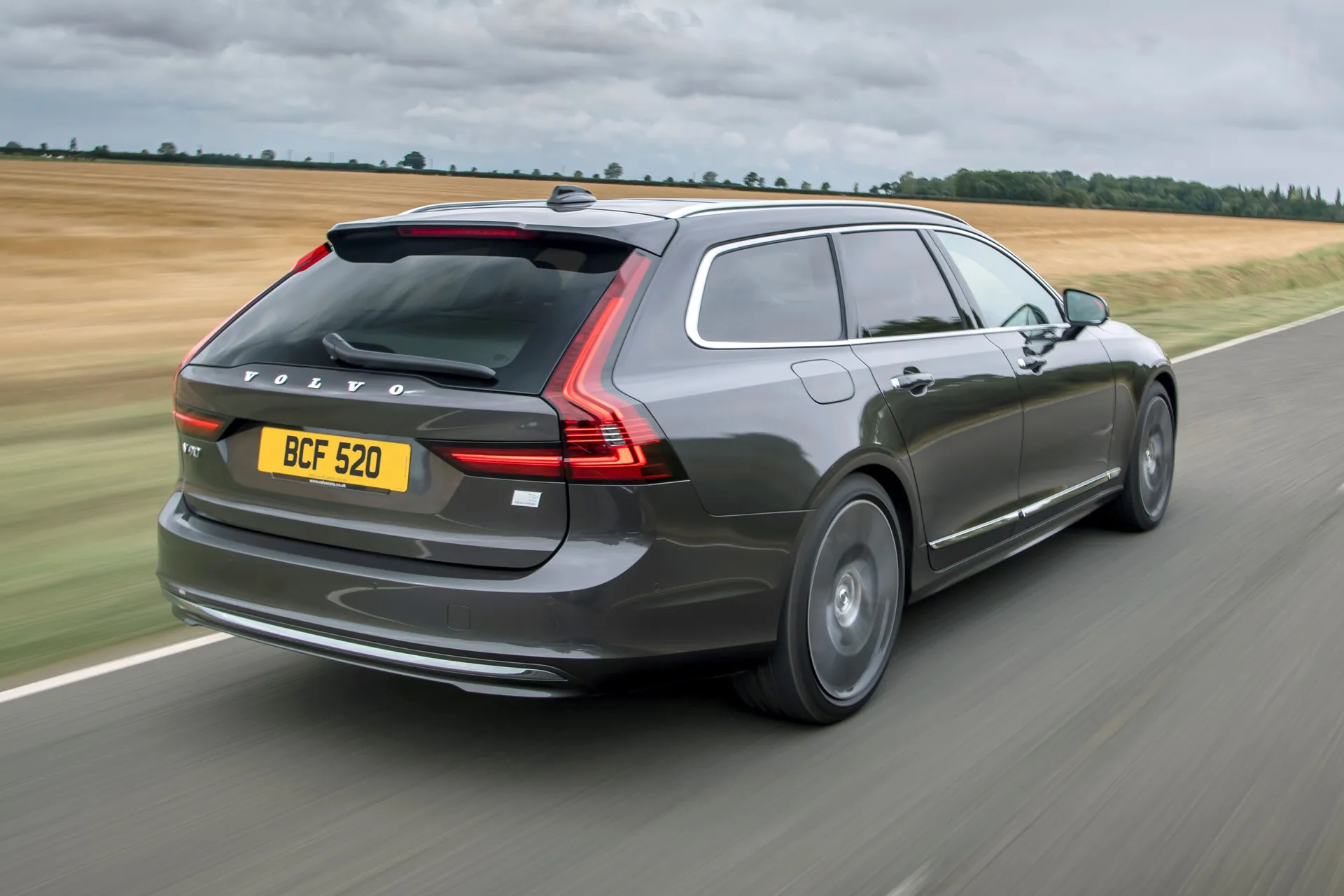
That’s no bad thing, because you’re far more likely to be cruising and covering long distances in your V90, rather than blatting along a quiet country road. As standard the Volvo V90 is fitted with a conventional steel suspension setup, and in this guise it does a decent job of filtering out road imperfections, although it is a bit less smooth on the bigger wheel options. Go for an Ultimate model and you get adaptive air suspension at the rear, which maintains ride height automatically and adapts each shock absorber to current road and driving conditions.
The suspension does a decent job of keeping the body’s movements under control, but there isn't much enthusiasm in the way the car changes direction. The steering is accurate enough but it doesn't have much feel, so although competent, the Volvo V90 is not really the driver’s choice in the class: that would be the BMW 5 Series Touring.
What engines and gearboxes are available in the Volvo V90?
The engine line up in the Volvo V90 was slimmed right down towards the end of its life, leaving two mild-hybrids and two plug-in hybrids. The entry-level 197PS B4 petrol is a decent unit, and with a hefty 300Nm of torque, it is certainly quick enough, so you’ll never feel like it doesn’t have enough power. The B5 is quicker still, but it might feel like a slightly unnecessary extra expense in a car that isn’t pretending to be some kind of sports car in disguise. The basic B4 is quick enough for most - especially as all Volvos are limited to 112mph - so you might as well make a saving.
If you need more torque for towing or carrying heavy loads – or just want improved fuel economy – then it’s worth looking at the older diesel options on the used market. The D4 with 190PS and a chunky 400Nm of torque will cover most eventualities, and it balances being usefully quick with strong economy. The 235PS D5 diesel option has 480Nm of torque, so it can pull anything wherever you want it to go, and with the security of four-wheel-drive, too.
Plug-in hybrid models are badged 'Recharge' just like Volvo's electric models of the time, which a little confusing. The Volvo V90 Recharge T6 plug-in hybrid is powerful and very fast, and is capable of impressive fuel consumption, but it only really make sense if you spend a lot of time in the city or doing regular short journeys and are able to charge regularly. That said, a 0-62mph time of just 5.5 seconds and an electric-only range of 54 miles is pretty tempting.
If you can afford the high sticker price, the fastest Volvo V90 is the Recharge T8 plug-in hybrid, and it'll rocket you to 62mph in 4.8 seconds, while still able to provide an electric-only range of 52 miles.
Refinement and noise levels
All the Volvo V90s conventional engines offer a good level of refinement and are generally quiet even when extended. Even the diesel options have low noise levels and not too much vibration in pretty much all conditions.
The PHEV models are the best of the lot, though. They can operate purely on electric power for long periods. This is of particular benefit if you travel in cities, where lower speeds allow the car to operate in pure EV mode for more of the time.
As for other sources of disturbance, tyre noise is mostly well-contained, but does tend to flare up on models that have the larger wheel and tyre combinations. Wind noise is also rarely a factor, with only the occasional rustle around the door mirrors at higher speeds.
Safety equipment: How safe is the Volvo V90?
Euro NCAP tested the Volvo V90 in 2017 and awarded it the full five-star rating. As standard, all V90s are fitted with head- and side airbags for the front seat passengers, as well as curtain airbags for both front and rear passengers. A knee airbag is fitted as standard for the driver also. Seat belt pretensioners and load limiters are fitted for both front and rear seat passengers, with a seat belt reminder for all seats.
ISOFIX child car seat mountings are standard in the rear seats and optional for the front passenger seat, with an airbag cut-off switch standard. An active bonnet is fitted, too.
With such a high rating for safety assist, it is no surprise that the Volvo V90 is fitted with a comprehensive range of driver assistance systems as standard. This includes automatic emergency braking that can detect pedestrians as well as cyclists, as well as speed assistance and lane assist.
An optional Intellisafe Surround safety pack adds a blind spot information system – that’ll warn you if a car’s hidden in your blind spot – cross traffic alert, which can stop you reversing out into oncoming traffic, and rear collision warning with mitigation. The last of those features helps protect you if the car you’re driving is involved in a rear end shunt.
Maximum EV range
The Volvo V90 Recharge T6 PHEV model has an official combined range of 54 miles, which is similar to other PHEV models that are comparable to the V90. It’s an excellent choice if you have a short commute and somewhere to charge the car, because it means you can get from A to B using cheap electric power alone, slashing your runnings costs.
MPG and fuel costs: What does the Volvo V90 cost to run?
"The Volvo V90's B4 (197PS) and B5 (250PS) petrol engines have fuel consumption figures of approximately 40mpg, and given they are both powerful engines, they do not need to be worked hard to make sensible progress in everyday driving."
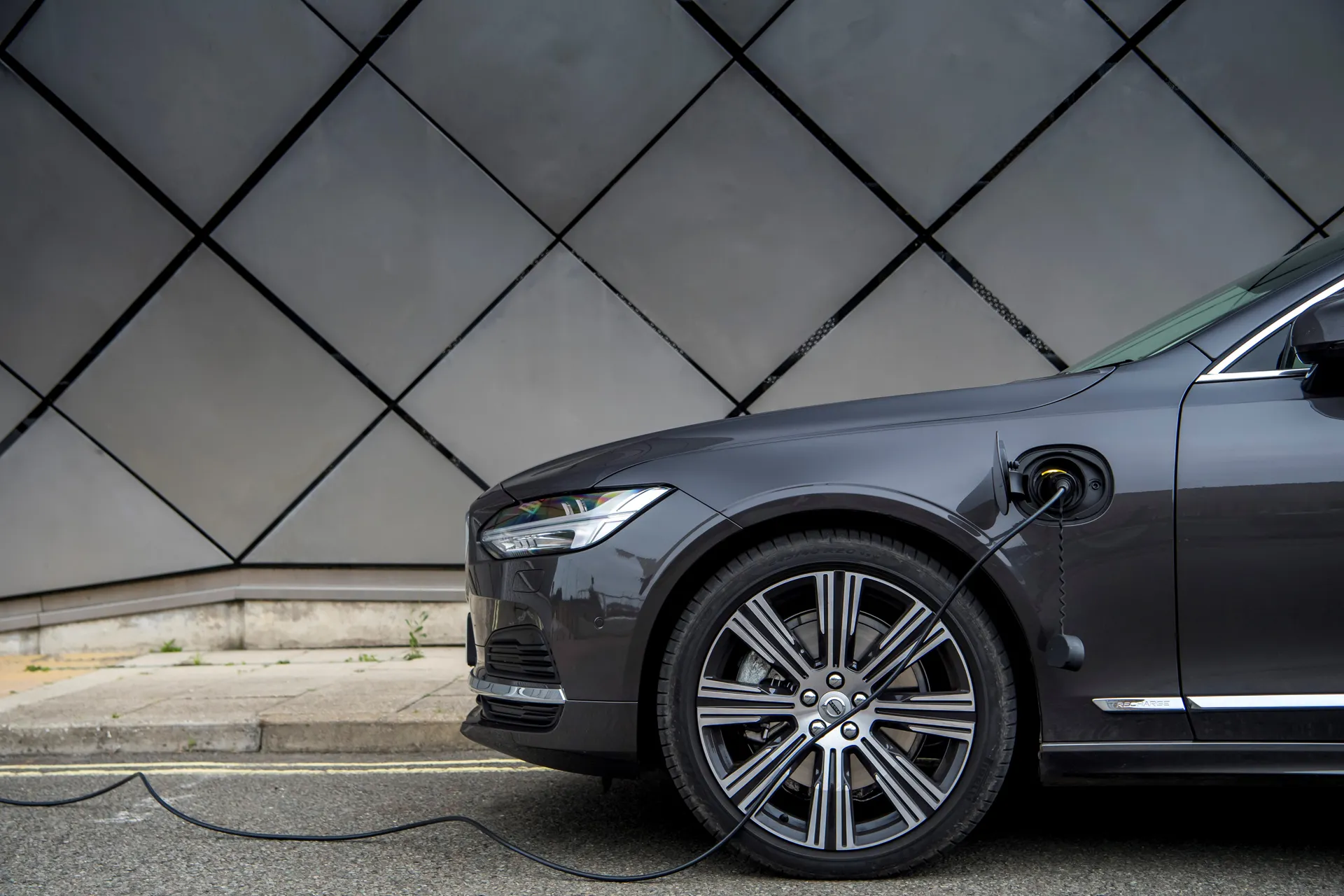
If you're looking for better fuel economy, you'll want to track down a diesel V90 on the used market as they're much better on fuel. The D4 claims 48mpg and the more powerful D5 42mpg in WLTP tests. Both should be able to manage high-30s in the real world when driven sensibly.
As for the Recharge hybrid V90s, the claimed 353.1mpg figure for the Recharge T6 will be virtually impossible to achieve unless you pretty much only drive at town speeds where the car can run on battery power alone. On a long run with the battery depleted, you can expect to get around 40mpg.
How reliable is the Volvo V90?
Take a look at the most recent HonestJohn.co.uk Satisfaction Index, and Volvo puts in an entirely adequate performance. The brand doesn't feature in the list of the 10 best manufacturers for reliability, but it doesn't feature in the list of the 10 worst, either. In terms of its performance on overall customer satisfaction, it placed 14th out of the 29 carmakers considered, and you can't get much more middle-of-the-road than that.
Insurance groups and costs
This is a big and quite expensive car with a range of powerful engines, so insurance ratings are going to be broadly on the high side. The lowest grouping (of 50, with 50 being the most expensive) you'll find is 27, but most models will be in the mid-thirties. Groupings go all the way up to 44 for the T8 plug-in hybrid.
VED car tax: What is the annual road tax on a Volvo V90?
The very earliest Volvo V90 models were on sale before April 2017 when the change in tax rules occurred, so you can get a model that's taxed under the older CO2-based system, which should be cheaper. The lowest you'll pay is a measly £35 per year, although that's only on a handful of low-spec diesel models.
All those registered from April 2017 onwards are taxed at the same flat rate for all petrol and diesel cars, a rate that currently stands at £190 per year. The mild-hybrids and plug-in hybrids, meanwhile, qualify for a discount, albeit of only a tenner.
Beware, though, because all cars that cost over £40,000 when brand new (including optional extras) are liable for an extra luxury car surcharge of payable between years two and six of the car's life. The vast majority of V90 models were priced at above that threshold, and only a handful of early low-spec models were less than that.
That surcharge currently stands at £410, taking your annual outlay for that five-year period up to £600. That means it's always worth performing an online check with the registration of any potential used purchase to be sure of what you're looking at.
How much should you be paying for a Volvo V90?
"Having been on sale for a good few years, there are plenty of used examples of the Volvo V90 to choose from. Just as well, because it's no longer on sale as a new car."
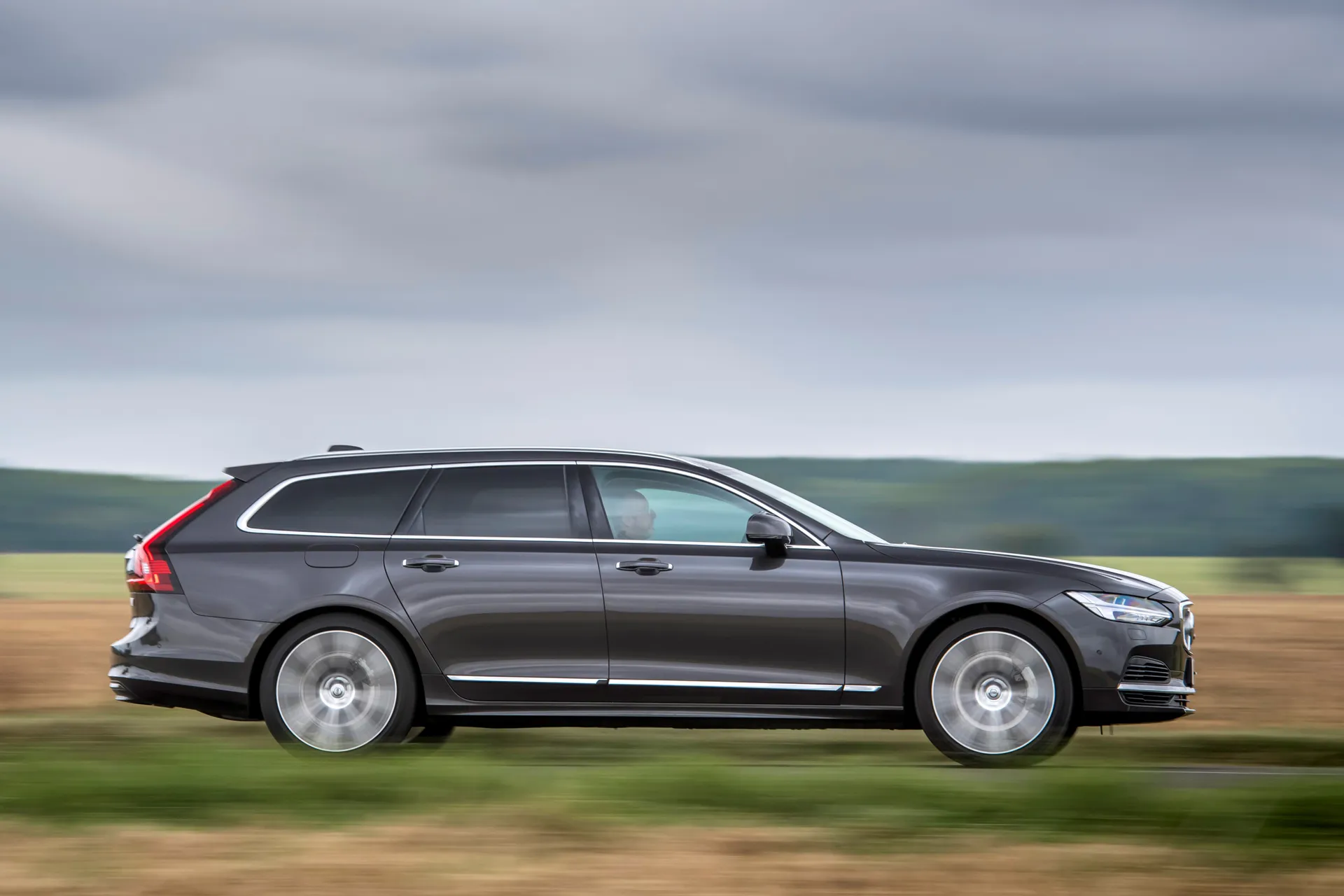
A quick search of the heycar classifieds turned up plenty of choice, with prices starting at around £17,000. For that, you're looking at a 2018 or 2019 car with and diesel engine and an automatic gearbox with around 70,000 miles under its wheels. You'll be looking at quite a lot more if you want one of the plug-in hybrids, mind.
Trim levels and standard equipment
Volvo V90 Plus models are fitted with adaptive cruise control and Pilot Assist, meaning they can pretty much drive themselves on the motorway and in slow moving queues of traffic. They also include convenience features such as auto-dipping LED headlights, automatic wipers, a power tailgate, 360-degree camera and front- and rear parking sensors. Even the basic model feels luxurious inside as it comes with two large infotainment screens, leather upholstery with heated front seats, and a DAB infotainment screen with 10 speakers and 19-inch alloy wheels.
Volvo V90 Ultimate models look even sportier with 20-inch alloy wheels, while other additional features include a panoramic roof as standard, tinted rear windows and a Bowers & Wilkins sound system.
Ask the heycar experts: common questions
Does the Volvo V90 have seven seats?
What does the V in V90 stand for?
Why is the Volvo V90 discontinued?
Get our latest advice, news and offers
Keep me updated by email with the latest advice, news and offers from heycar.
By submitting you agree to our privacy policy
